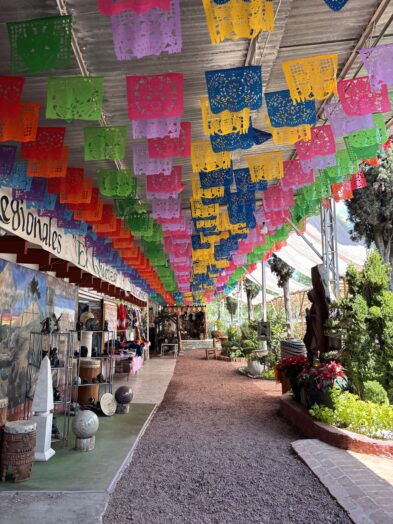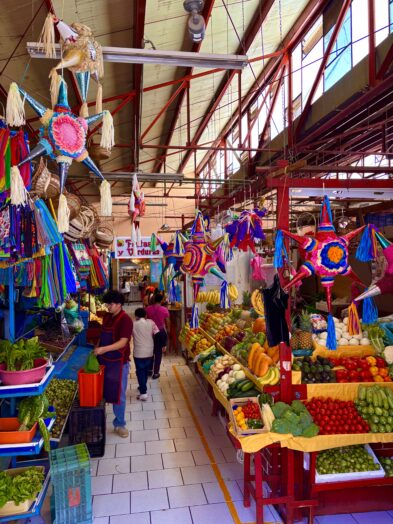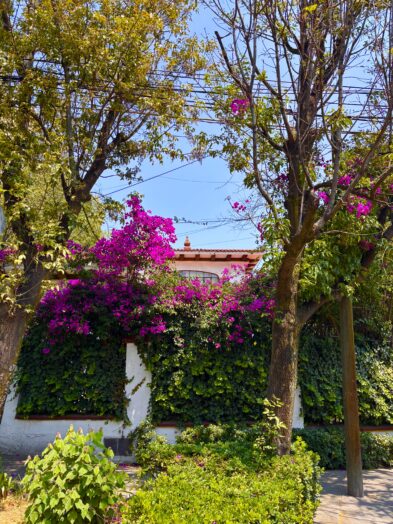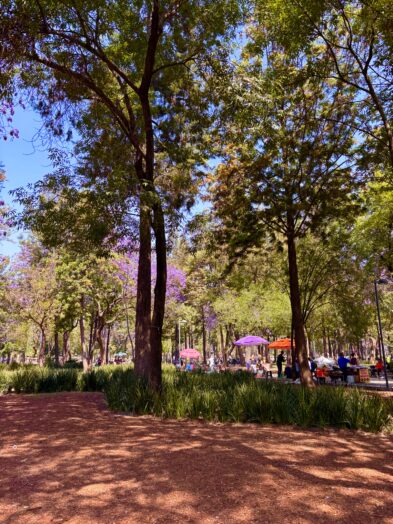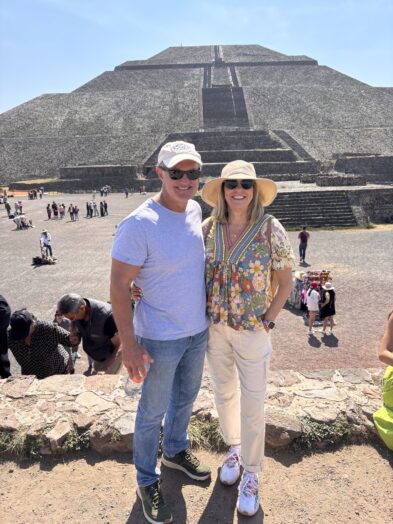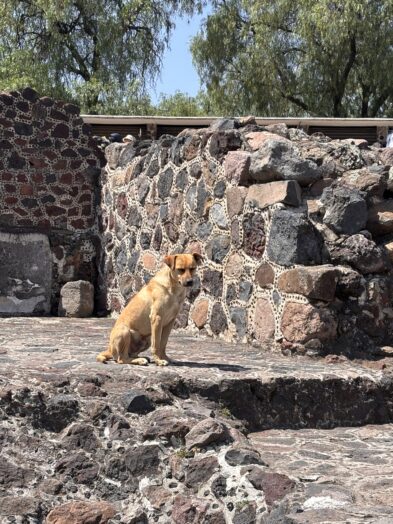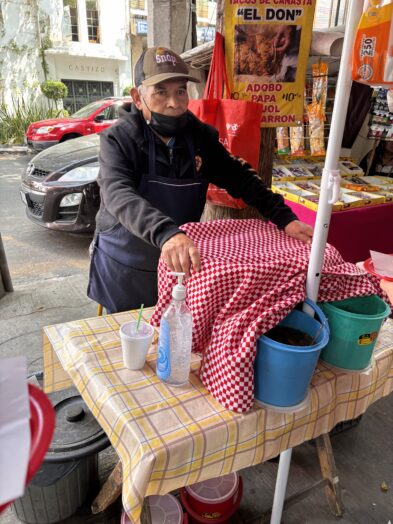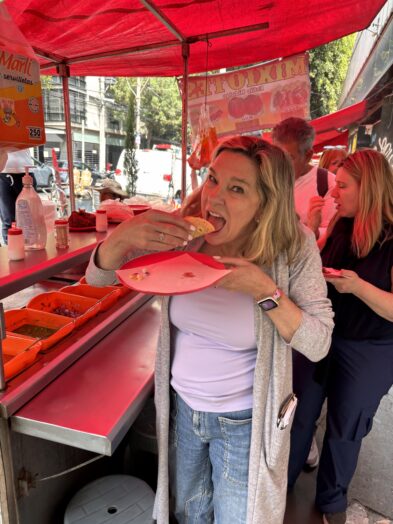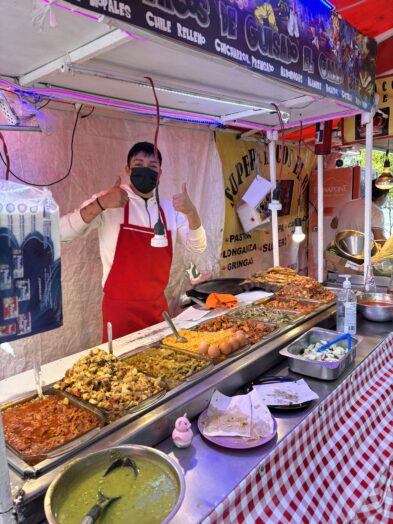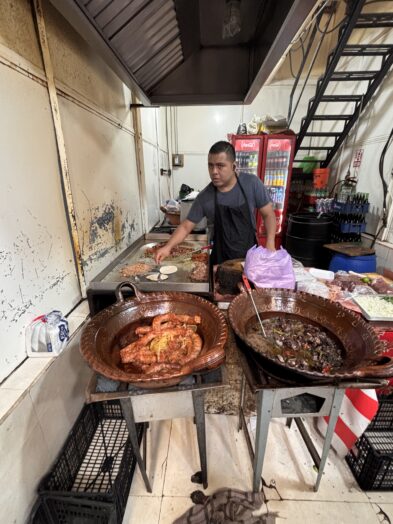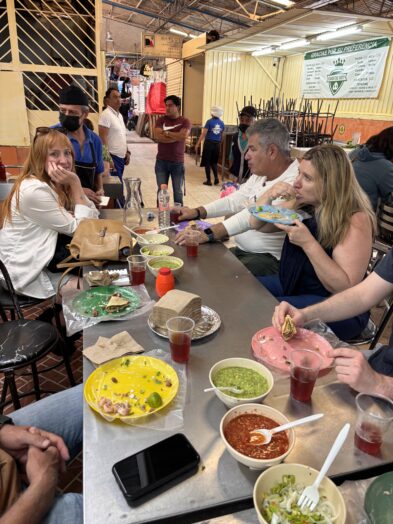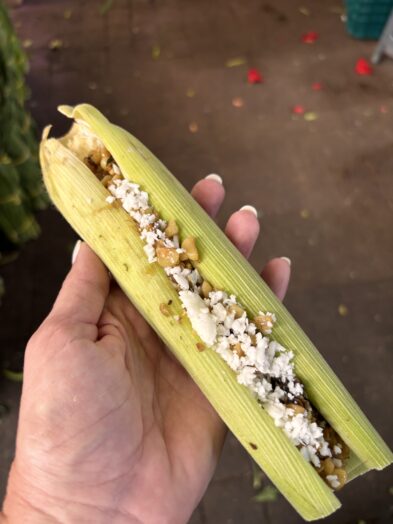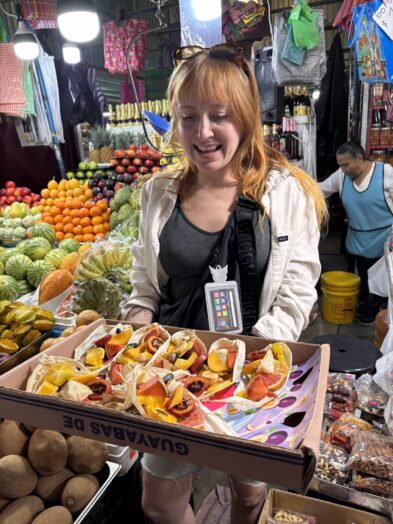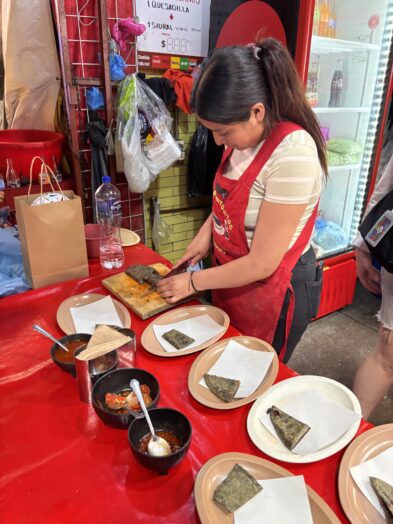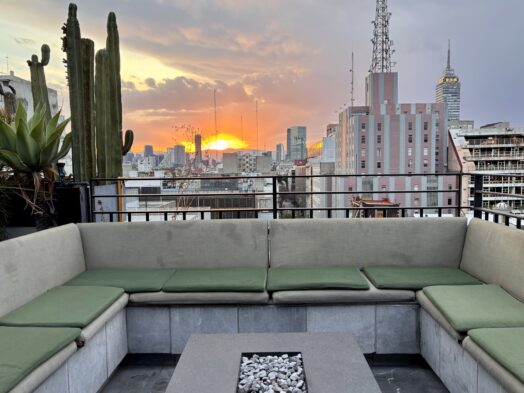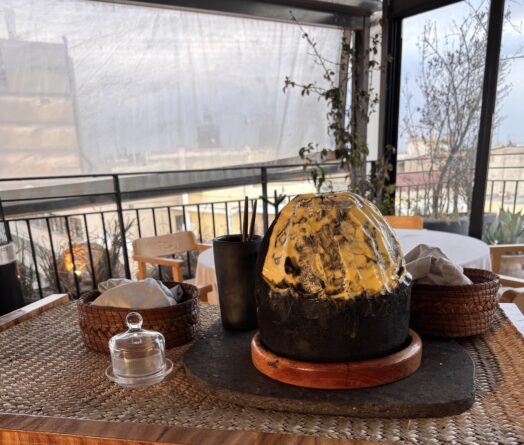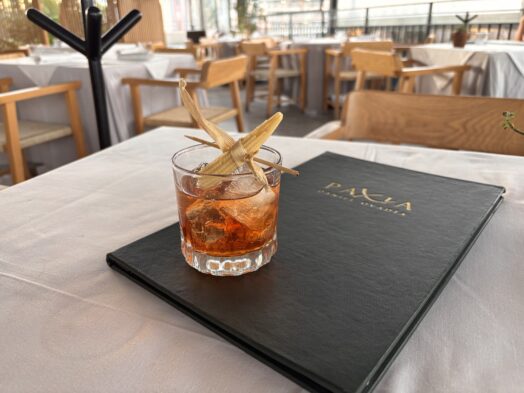How To See Mexico City In 3 Days
Mexico City wasn’t really on my radar screen for travel, but my foodie son spent time and kept insisting that I needed to visit, for the culture, but also for the amazing food scene. Let’s just say I was skeptical (not to mention my tremendous fear of Montezuma’s Revenge.)
I’ve written before that I’m not a huge advance planner (although I’m getting better), but this time, I did my research and booked some amazing tours, including an Eat Like a Local Mexico City street food tour. And somehow, we were able to see most of the city’s top attractions and eat some amazing food, in a whirlwind three days, so I thought I’d share our itinerary here.
Arrival in Mexico City
We arrived late in the afternoon on a Saturday after a long travel day of connections and delays. I’ll be honest, my first impression of Mexico City was not good. It was crowded (22 million people live there!), traffic was horrible, it felt dirty, and it stunk. But stay with me because the city definitely redeemed itself. I would soon learn that there are a lot of laws on pollution which have greatly improved the air quality.
We stayed in the Centro Historico (not my best recommendation, but more on that later) and found ourselves wandering aimlessly to find purified water and something (SAFE) to eat. We found a sketchy-looking taco place but decided to take a risk, because most other restaurants near our hotel were finer dining and we were just tired. After 20 minutes of trying to use Google translate to decipher the menu, we gave up and ordered based on familiar sounding words, like pollo and taquito. The food was actually fabulous but mucho caliente. We survived our first night.
Day 1: Exploring the Neighborhoods of Mexico City
Not that I planned it this way, but Sunday being our first day in the city was dreamy. On Sundays, the city turns green. They close the interior streets for runners and cyclists from 8am-2pm and most become pedestrian-only streets. So it was the perfect day to get out and explore. We had booked a private half-day walking tour of the city to get our bearings. Our guide told us so much about the city, culture, politics, and food. The city was surprisingly clean and safe. There were city workers everywhere weeding and planting flower beds, washing and scrubbing sidewalks, and there was a huge presence of public safety officers (our guide explained it’s like this all the time to maintain peace and safety).
The Best Places to Visit in Mexico City
We started our tour in Constitution Square, known locally as El Zócalo, is the vibrant heart of Mexico City and one of the largest public plazas in the world. Steeped in history, the square has been a central gathering place since the time of the Aztecs, once serving as the ceremonial center of the ancient city of Tenochtitlán. After the Spanish conquest, it was transformed into the political and religious core of colonial Mexico. Today, the Zócalo is surrounded by some of the city’s most iconic landmarks, including the Metropolitan Cathedral, the National Palace, and the ruins of the Templo Mayor. It is a stage for national celebrations, political rallies, cultural events, and everyday local life. A massive Mexican flag waves proudly at its center, symbolizing the country’s enduring spirit. As both a historic and modern-day focal point, Constitution Square captures the essence of Mexico City’s past, present, and future.
Within the square is the Metropolitan Cathedral of the Assumption of the Most Blessed Virgin Mary into Heaven, commonly known as the Metropolitan Cathedral, a majestic symbol of Mexico City’s colonial and religious heritage. Located on the northern side of the Zócalo, the city’s main square, it is the largest and oldest cathedral in Latin America. Construction began in 1573 atop the ruins of the Aztec Templo Mayor and continued for nearly 250 years, resulting in a stunning blend of architectural styles, including Gothic, Baroque, and Neoclassical. The cathedral’s massive façade, twin bell towers, and richly adorned altars showcase centuries of Spanish influence and devotion. Inside, visitors can admire intricate chapels, the ornate Altar of the Kings, and a grand pipe organ. Due to the soft soil of the ancient lakebed it sits on, the cathedral has undergone extensive restoration to prevent sinking. Today, it stands not only as a place of worship but also as a historical monument that reflects the cultural fusion and resilience of Mexico City.
In the heart of Mexico City, two fascinating landmarks—the House of Tiles (Casa de los Azulejos) and the Casa de los Azulejos (House of Amulets)—offer rich glimpses into the city’s colonial and artistic heritage. The House of Tiles is an 18th-century palace adorned with stunning blue-and-white Talavera tiles from Puebla that cover its façade, making it one of the most iconic buildings in the historic center. Originally built by the Count of the Valley of Orizaba family, it later became home to the Sanborns restaurant, blending history with modern culture. Its interior boasts elegant architecture, a grand staircase with a mural by José Clemente Orozco, and a charming courtyard that reflects the opulence of colonial Mexico. Meanwhile, the lesser-known Casa de los Amuletos (House of Amulets), tucked within the Centro Histórico, is a unique space dedicated to Mexican spiritual traditions and folk healing. This quirky, vibrant museum showcases an eclectic collection of charms, talismans, and ritual objects used throughout Mexico’s history for protection, luck, and healing. Together, these two sites celebrate the artistry, mysticism, and cultural depth that define Mexico City’s rich past and present.
Alameda Central is a historic and picturesque urban park in the heart of Mexico City, offering a tranquil escape amid the bustling metropolis. We were so lucky to be there the week the Jacaranda trees were blooming! Established in 1592 by Spanish Viceroy Luis de Velasco, it is the oldest public park in the Americas. Originally intended as a space for leisure among the city’s elite, the park has evolved into a beloved gathering spot for people of all walks of life. Lined with tree-shaded walkways, elegant fountains, and classical statues, Alameda Central is a place to stroll, relax, and take in the artistic and cultural vibe of the city. It is flanked by significant landmarks such as the Palacio de Bellas Artes and the Museo Mural Diego Rivera, making it a cultural hub as well as a green space. Today, Alameda Central reflects Mexico City’s blend of colonial history and contemporary urban life, serving as both a historical monument and a vibrant public space.
A few places we didn’t get to see but will on our next trip:
Chapultepec Park, or Bosque de Chapultepec, is one of the largest urban parks in the Western Hemisphere, offering a green oasis in the heart of Mexico City. Within its vast expanse lies the National Museum of Anthropology (Museo Nacional de Antropología), Mexico’s most visited museum, renowned for its extensive collection of pre-Columbian artifacts, including the iconic Aztec Sun Stone. Art enthusiasts can explore the Museum of Modern Art (Museo de Arte Moderno), which showcases significant works from the Mexican School of Painting and the Breakaway Generation. The Chapultepec Zoo, established in 1924, houses over 1,800 animals and is notable for its conservation efforts and diverse species. For contemporary art, the University Museum of Contemporary Art (MUAC) at UNAM presents cutting-edge exhibitions from both Mexican and international artists. Nature lovers can stroll through the Chapultepec Botanical Garden, which spans 5.3 hectares and features a rich collection of native and exotic plants. Lastly, the Frida Kahlo Museum, located in the Coyoacán district, offers an intimate glimpse into the life of the iconic artist; due to its popularity and the absence of on-site ticket sales, it’s essential to purchase tickets well in advance through the official website.
This is a cool place our guide told us about: Zinco Jazz Club, nestled in Mexico City’s Centro Histórico, offers an intimate and atmospheric venue for jazz enthusiasts. Located in the basement of a former Bank of Mexico building, the club’s red and black décor creates a moody ambiance reminiscent of classic jazz clubs. It hosts both local and international jazz musicians, making it a popular spot for live music lovers. With a capacity of around 50 guests, reservations are recommended to secure a spot. The club operates from Wednesday to Saturday, opening at 9:00 PM, with performances typically starting around 10:30 PM. Guests can enjoy a selection of drinks and light fare while immersing themselves in the vibrant jazz scene.
Day 2: Touring the Mexico City Pyramids
We took a private tour of the Mexico City pyramids and I highly recommend this as the best way to see them.
The Teotihuacán pyramids, located about one hour outside Mexico City, are among the most significant and mysterious archaeological sites in the Americas. Founded around 100 BCE, Teotihuacán was once a thriving metropolis and the largest city in the pre-Columbian Americas, home to over 100,000 people at its peak. The city’s name, meaning “the place where the gods were created,” was given by the Aztecs who discovered the ruins centuries after the city’s decline around 550 CE. The most iconic structures at the site are the Pyramid of the Sun, one of the largest pyramids in the world, and the Pyramid of the Moon, both aligned with celestial bodies and used for ceremonial purposes. Another must-see is the Temple of the Feathered Serpent (also known as the Temple of Quetzalcoatl), which features intricate carvings of the feathered serpent deity. The Avenue of the Dead, a grand central boulevard stretching over a mile, connects these main structures and provides insight into the city’s complex urban planning. Visitors can also explore residential compounds, murals, and the Teotihuacán Museum, which houses artifacts that reveal the city’s cultural and religious significance.
We stopped for an amazing lunch right outside the pyramids at Rancho Azteca. Rancho Azteca in Mexico City is a hidden gem celebrated for its rustic ambiance and traditional Mexican fare. One of their standout dishes is the molcajete bowl, a sizzling stone vessel brimming with grilled meats, nopales (cactus), fresh cheese, and a rich, smoky salsa. The molcajete keeps the dish hot and bubbling, delivering a bold and flavorful experience that feels both authentic and indulgent. It’s a must-try for anyone seeking a true taste of Mexico’s culinary heritage.
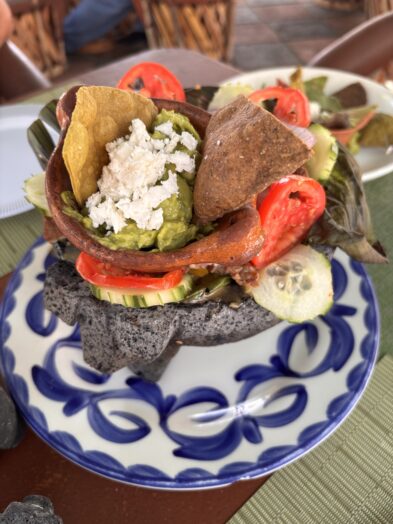
Day 3: Best Mexico City Food Tour
I can’t say enough good things about the tour company, Eat Like a Local Mexico City (and no, they did not comp my tour; I paid for it). First let me say, I was terrified of getting sick so I was definitely leery of eating street food. But I did the research and this company has tons of glowing 5-star reviews – and not a single incidence of anyone getting sick. Our guide, Fer, was a Mexico City native and food writer which made the experience even more magical.
I book a food tour or cooking class every single time I travel to a new destination. Food is how I learn about the local culture. The Eat Like a Local street food tour isn’t your average touristy food crawl. It’s a deep dive into neighborhoods you might not explore on your own, guided by passionate locals who treat food as a storytelling tool. Along the way, you’ll experience not just the flavor of traditional Mexican foods, but the culture, community, and warmth that define CDMX.
The tour often begins with a classic street snack: tacos de canasta, or “basket tacos.” We stopped at Don Antonio’s, or better known as “El Don.” These soft, pre-made tacos are gently steamed and stored in a basket wrapped in cloth to keep them warm. Typically filled with simple but flavorful ingredients like adobo chicken, mashed potatoes, beans, or chicharrón prensado (pressed pork skin), they’re the kind of comfort food you eat standing on a street corner, watching the city buzz around you. Don’t let their humble appearance fool you—these tacos are rich, savory, and the ultimate grab-and-go bite. You can buy a taco for roughly 50 cents.
Next up was Mixiotes for a third generation recipe of pechote, a lesser-known but unforgettable pork dish. Pechote refers to pork that’s marinated in achiote and spices, then wrapped in maguey (agave) leaves and slow-roasted underground or in a pit oven. The result? Incredibly tender, aromatic meat with smoky undertones and a melt-in-your-mouth texture. This dish is a rare find and a true gem of the tour. Again, so very yummy. The sauces are what make these dishes.
No food tour in Mexico City would be complete without a stop at a taco al pastor stand. Inspired by Lebanese shawarma, this dish features spit-roasted pork marinated in a blend of dried chilies, spices, and pineapple juice. Sliced fresh from the trompo (vertical rotisserie), the meat is tucked into a warm corn tortilla and topped with pineapple, onions, and cilantro. It’s a mouthwatering combination of savory, sweet, and spicy, and arguably the most iconic street taco in the city. Incidentally, I learned that you would not eat pastor in the early part of the day, only in the evening.
Next, we headed in Jamaica Market (pronounced ha-MY-ka) adds a burst of color and culture to the tour. Known for its endless rows of fresh flowers, it’s also home to an amazing variety of local snacks and drinks. Sip on fresh hibiscus juice (agua de jamaica), try tamales in regional styles, or nibble on roasted grasshoppers (chapulines) if you’re feeling adventurous. The market is lively, fragrant, and full of local vendors who have been feeding the community for generations. We enjoyed some carnitas make with pork cheeks, and Tepache, a traditional Mexican fermented beverage made from pineapple rinds, brown sugar (piloncillo), and spices like cinnamon and cloves. Slightly fizzy and mildly alcoholic, tepache has a sweet, tangy flavor and is often served chilled over ice—sometimes mixed with beer for an extra kick. Popular at street stands and local markets, it’s a refreshing, probiotic-rich drink that reflects Mexico’s ingenuity in using every part of the fruit.
Next, we stopped at Exquisitos Tacos for some uniquely different bites. One of the highlights of the tour is sampling cecina, a type of thinly sliced, salted, and sun-dried beef or pork. Unlike jerky, cecina remains soft and pliable, often grilled just before serving to release its rich, meaty flavor. Served with fresh tortillas, avocado, lime, and salsa, cecina is a showcase of the traditional preservation methods still practiced in rural parts of Mexico—and it’s delicious. We also enjoyed a fabulous sausage that I still think about today, longaniza verde. It is a regional specialty from Toluca, Mexico, known for its vibrant green color and bold flavor. Made with ground pork, fresh green herbs like cilantro and parsley (where it gets its color), Poblano and Serrano green chiles, nuts including pumpkin seeds, almonds, and peanuts, and a blend of spices. It’s typically grilled or pan-fried and served in tacos or alongside traditional sides like nopales or beans.
I would be remiss if I didn’t tell you about the end of our tour, the edible bug market. No, I didn’t not partake but my husband did (he would later claim that I only got sick at the end of the trip because I did NOT eat the bugs; he did not get sick.) Eating insects is a deeply rooted tradition in Mexico City, where entomophagy (the consumption of insects) has been practiced since Aztec times. Today, this culinary heritage thrives in local markets like Mercado de San Juan and Mercado Medellín, where vendors offer a variety of edible insects such as chapulines (toasted grasshoppers), escamoles (ant larvae), and chicatanas (flying ants). These insects are often seasoned with chili, lime, and salt, and are commonly enjoyed in tacos, tamales, or as snacks. My husband ate a grasshopper and a rather large beetle, which he claimed tasted a bit smokey.
Our tour ended with a visit to the candy section of the market and a chance to try chamoy (I’m not a fan). Chamoy is a tangy, spicy, and slightly sweet Mexican condiment made from pickled fruit, typically apricots or plums, combined with chili powder, salt, and sugar. It’s often used to add a bold kick to snacks like fruit, chips, or even ice cream, and can also be found as a drizzle over drinks such as micheladas. The combination of sour, salty, and spicy flavors makes chamoy a beloved and versatile ingredient in Mexican street food culture.
What makes the Eat Like a Local experience stand out is their commitment to supporting locals through their Game Changes Program, which empowers young women and girls from Mexico City’s La Merced market community. Rather than traditional charity, the program fosters mutual growth through mentorship, English lessons, emotional education, and culinary experiences. This symbiotic approach not only enriches the travelers’ experiences but also creates lasting, positive change within the community. The group the program is currently supporting is headed to Scotland to learn English. I just love working with and supporting local organizations who give back!
Best Restaurants in Mexico City
Remember, this is why I came here in the first place! Perhaps the best piece of advice we got about Mexico City restaurants? If you see a taco stand with a line, get in line!
Mexico City is a culinary playground, and a few standout restaurants capture its rich and diverse flavors. El Califa de León, a humble taco stand recently awarded a Michelin star, is renowned for its deceptively simple yet perfectly executed tacos, especially the tender taco de costilla (rib taco) served on freshly made tortillas. For a casual and comforting local experience, La Casa de Toño in Zona Rosa is a must-visit for its legendary pozole, a hearty hominy soup, as well as flautas, sopes, and other classic antojitos served in a bustling, friendly setting. Contramar, a seafood lover’s paradise in the Roma neighborhood, is famous for its tuna tostadas and pescado a la talla—a whole grilled fish with red and green salsas split down the middle. In the mood for street-style tacos with a northern twist? Tacos Orinoco delivers with their crispy-edged tacos de chicharrón and flame-grilled meats, served on flour or corn tortillas. For a more refined culinary experience, Paxia offers elevated Mexican cuisine with artful presentations, blending traditional ingredients with contemporary techniques to create unforgettable dishes that celebrate the country’s gastronomic heritage. We especially enjoyed the tableside presentation where butter covered in ash is scraped into a dish for your bread. We also enjoyed a lovely brunch in Polanco neighborhood at Garabatos (chilaquiles for the win!).
We actually got a little tired of Mexican food after three days (criminal, I know!) so we found a cute little Italian restaurant in Zocalo that was a welcome surprise. Non Solo
Here’s an interesting tidbit: Mexico City has the second largest Lebanese population in the world. Great Lebanese food. If you’re a really adventurous eater, there is a Mexican exotic food market near Chinatown.
Where to Stay In Mexico City
I write a lot about how I’m an OCD trip planner because I don’t have the patience or tolerance when things go wrong. I made a mistake on this trip and booked the wrong hotel in my choice of places to stay in Mexico City. It got great reviews, but if you read deep into the comments, you’ll see the problems with it.
As I mentioned before, we stayed in the Centro Historico, the Zocalo neighborhood. It was okay, just a bit crowded and exceedingly gritty. But it was fine, and we ended up meeting a lot of cool people there. We stayed at the NH Collection Mexico City Centro Histórico offers a blend of modern comfort and historical charm, situated just steps from the iconic Zócalo square, Metropolitan Cathedral, and Templo Mayor archaeological site. This 4-star hotel features 105 contemporary rooms adorned with modern Mexican décor in soothing neutral tones, complemented by amenities such as free Wi-Fi, 49-inch TVs, Nespresso machines, and rainfall showers. Guests can indulge in a variety of Mexican and international dishes at the on-site restaurant or unwind with a drink on the fifth-floor terrace, which offers stunning city views. The hotel also boasts a well-equipped 24-hour gym, a business center, and meeting facilities accommodating up to 400 attendees. As an eco-certified property, it participates in the Green Key program, reflecting its commitment to environmental sustainability. With its prime location, modern amenities, and dedication to eco-friendly practices, the NH Collection Mexico City Centro Histórico provides an ideal base for both leisure and business travelers exploring the heart of Mexico City.
If you’re looking for the best hotel in Mexico City, I recommend choosing something in the Polanco or Condesa neighborhood.
Luxury Hotels in Mexico City
For travelers seeking an indulgent stay, Four Seasons Hotel Mexico City in Juárez is the epitome of elegance. This timeless luxury hotel features a tranquil inner courtyard that feels like a hidden oasis in the heart of the city. Guests can unwind at the world-class spa, relax by the rooftop pool, and savor exceptional cuisine at Zanaya, known for coastal Mexican flavors, or enjoy craft cocktails at the chic Fifty Mils bar. Just down the boulevard in the Reforma area, Sofitel Mexico City Reforma blends contemporary French sophistication with Mexican charm. With sweeping panoramic views of the city skyline, this sleek high-rise offers an indoor pool, outstanding service, and prime proximity to iconic landmarks such as El Ángel de la Independencia and Chapultepec Park. For those who want to immerse themselves in the city’s historic heart, Zócalo Central Hotel is a fantastic choice. Located directly on Constitution Square, it offers rooms with views of the Metropolitan Cathedral and free 24/7 access to snacks and drinks. Its rooftop restaurant not only serves delicious meals but also provides some of the most impressive vistas in the Historic Center.
Boutique Hotels in Mexico City
Travelers looking for style and comfort without the ultra-luxury price tag will find excellent options in Mexico City’s boutique hotels. Casa Polanco Boutique Hotel, located in the upscale Polanco neighborhood, is a serene and stylish retreat housed in a beautifully restored mansion. Its location is ideal for exploring Chapultepec Park, visiting top museums, and enjoying world-class shopping and dining. Over in Cuauhtémoc, Hotel Carlota is a favorite for its edgy design and laid-back, artsy vibe. With its concrete finishes, modern art, and Instagram-famous glass-walled pool, it’s a cool and contemporary choice near the trendy Roma and Reforma districts. For something even more intimate, the best boutique hotel Mexico City is Casa Decu in Condesa offers spacious Art Deco-style suites, many with kitchenettes—perfect for longer stays. The hotel is surrounded by leafy, walkable streets, and is just steps away from charming cafes, parks, and boutiques. The rooftop terrace is a peaceful place to unwind after a day of exploring.
Budget-Friendly Hotels & Hostels
Budget-conscious travelers will find plenty of value without sacrificing comfort or style. Hostel Home in Condesa offers a warm, welcoming atmosphere that feels like staying with friends. With a mix of dorms and private rooms, and a location just a block from Parque México, it’s a great choice for solo travelers or backpackers. In the Historic Center, Selina Mexico City Downtown combines the amenities of a boutique hotel with the social vibe of a hostel. It features coworking spaces, stylish rooms, a vibrant rooftop bar, and a calendar full of community events. It’s ideal for digital nomads and those who want to mix work and play. Lastly, Hotel MX Roma in Roma Norte is a clean, modern, and affordable option that includes a free breakfast. It’s within walking distance of some of Mexico City’s best coffee shops, art galleries, and local markets, making it a perfect home base for discovering the capital’s creative side.
The Best Time to Visit Mexico City
The best time to visit Mexico City is during the dry season, from March to May, when the weather is pleasantly warm, with daytime temperatures typically in the 70s and low 80s°F (21–28°C). Springtime also brings blooming jacaranda trees, adding a vibrant splash of purple throughout the city. While this period is ideal for comfortable sightseeing, it’s also one of the most popular times for tourists, so expect larger crowds at major attractions. For a quieter experience with similarly mild weather, October to early December is another great option—just after the rainy season ends and before the holiday rush. Avoid visiting during June to September, the peak of the rainy season, when afternoon downpours are common, though the city remains lush and green.


